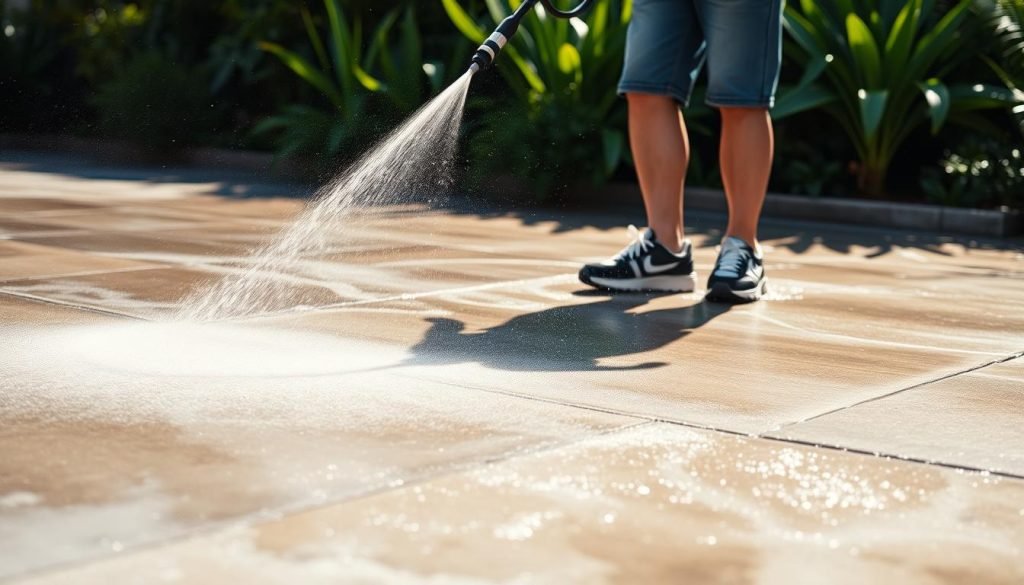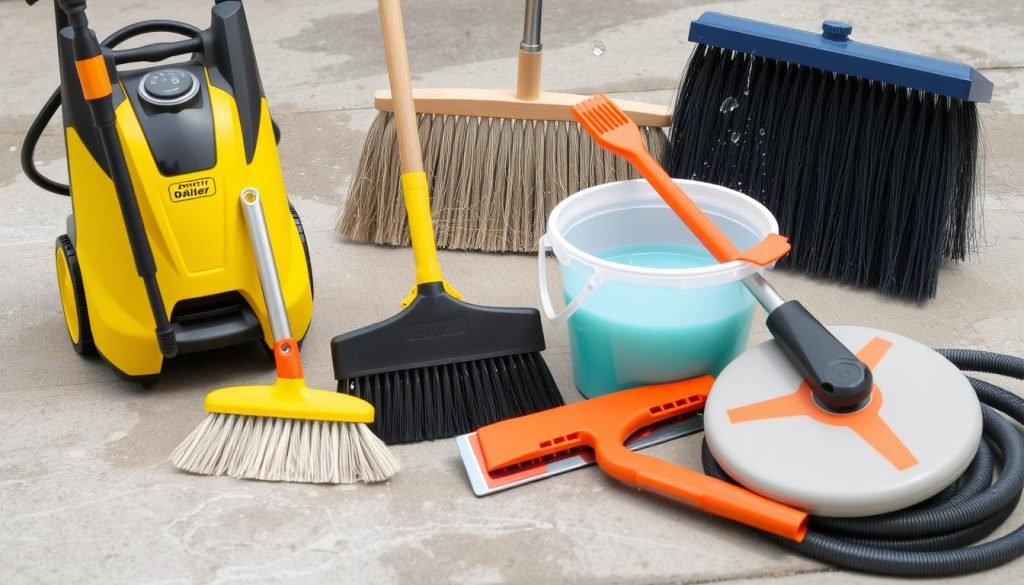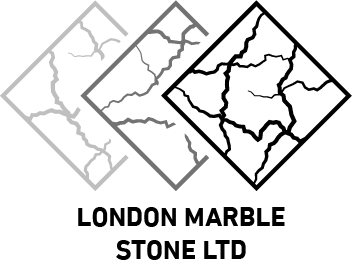Keeping concrete clean is key to its longevity. In the UK, damp weather and cold can harm surfaces. Regular cleaning, especially once a year, helps avoid mould, stains, and wear.
For help, call 07888 526686 or email Info@londonmarblestone.co.uk. Start by preparing your area, then apply a pre-treatment if needed. Finish with a thorough rinse. This method keeps your paths, patios, and driveways looking good, even in Britain’s unpredictable weather.
Key Observations
- Annual cleaning reduces moisture-related damage on concrete structures.
- Early intervention stops mould and moss from weakening surfaces.
- Pre-treatment with vinegar or detergent targets daily grime.
- Targeted pressure washing reaches up to 90% of surface stains.
- Protective measures keep floors safer and more slip-resistant over time.
Understanding the Nature of Concrete
Concrete’s surface is porous, which means it can soak up water, dirt, and pollutants. This leads to tough stains that need special care. Cleaning concrete gently helps avoid pushing dirt and stains into cracks, which can make moss or mould grow back.

Experts say washing concrete thoroughly at least once a year can prevent lasting damage. In the UK, damp weather makes surfaces slippery, so picking the right cleaner is key. Alkaline cleaners are good for car stains, while acidic ones tackle rust. Always test a small area first to avoid colour changes.
- Regular cleaning, once or twice a year, helps stop mildew from coming back.
- Slabs that haven’t been cleaned for a while might need more than one cleaning to look good again.
- Using too much pressure when washing can push spores deeper, making algae come back fast.
Understanding the chemistry of concrete surfaces helps remove stains better. This approach protects the concrete while getting rid of stains effectively. Choosing the right time and cleaner keeps your floors looking great for years.
Essential Equipment for Cleaning Concrete
Many people ask how to clean concrete floors without damaging them. The right tools keep the surface safe and last longer. A 3,000 PSI pressure washer is usually enough for driveways or patios.
Hot-water models make cleaning faster and more effective against grime.
Protective Gear
It’s important to protect yourself when using cleaning products. Gloves keep your skin safe from harmful chemicals. Safety glasses protect your eyes from splashes.
Wearing strong boots is key to avoid slipping on wet surfaces. This is especially true when algae or moss is present.
Cleaning Solutions and Tools
A mild cleaner is good for everyday use, while strong formulas tackle tough stains. Many prefer a pH-neutral cleaner to protect polished finishes. Stiff-bristled brushes help remove stubborn dirt.
For serious grease or oil stains, trisodium phosphate is a good choice.

How to Clean Concrete: Step-by-Step Process
Start by sweeping away loose dirt with a broom or blower. For tough stains like oil or rust, use special cleaners that soak for a day. A strong pressure washer, at least 3,000 PSI, works best. Keep it about 12 inches away to avoid damaging the surface.
Wear goggles and gloves to protect yourself. About 20% of pressure washer injuries happen without these safety items.
Here’s a quick guide:
- Pre-treat spots with degreasers or mild acid-based cleaners.
- Gradually power-wash from one side, keeping the wand in motion.
- Rinse any residue and allow the area to dry fully.
- Use a high-quality concrete sealer to guard against moisture and UV damage.
Cleaning regularly can make your concrete last up to 50% longer. For better cleaning, try a turbo nozzle, which can increase efficiency by 30%. Sealing after each wash prevents water damage and keeps the floor looking good.
Tips for Cleaning Concrete Floors Indoors
Indoor concrete floors need a careful cleaning routine. Sweeping once a week removes 80% of dirt. Many ask if cleaning concrete is like cleaning granite. Generally, a gentle cleanser and avoiding harsh acids keep both looking great.
Preventing Dust and Debris Buildup
Grit and dust can make floors look dull. It’s important to sweep or vacuum before mopping. A pH-neutral cleaner is best for most concrete finishes, protecting sealers.
Quickly cleaning spills also helps avoid stains. This means less scrubbing later.
Maintaining Glossy Finishes
Polished floors need special care to keep their shine. Use a mild cleanser with a soft mop or microfibre pad. Water and a bit of natural dish soap are often enough for a deep clean.
Avoid using abrasive pads to prevent scratches. This keeps the floor shiny and protected.
Effective Methods for Removing Stains and Discolouration
Stubborn marks can ruin your concrete’s look. But, there are ways to remove them. It’s important to act fast, whether it’s for outdoor floors or cleaning granite countertops. Each surface needs the right products to remove stains without damaging it.
Oil Spills and Grease
Oil and grease soak into concrete quickly. A degreaser or baking soda can pull out the residue after 30–60 minutes. Use a pressure washer from B&Q to remove the loosened dirt.
If oil is still there, use muriatic acid carefully. A mild dish soap and warm water mix can be applied until the surface is clean.
Rust and Mould
Rust can be treated with vinegar spray for under an hour. Vinegar and baking soda can remove stubborn patches. For mould in damp areas, mix 3/4 cup of bleach with 1 gallon of water.
Always test any cleaning solution on a hidden area first. This ensures it won’t damage your concrete.
Choosing Between Homemade and Commercial Cleaning Solutions
Many homeowners prefer eco-friendly cleaning methods. Homemade solutions like baking soda or diluted vinegar work well for light marks on basement floors. They can also help with mild odours by neutralising smells.
In places like Toronto, reliable cleaning methods are crucial. The weather changes and dampness often occur, making good cleaning essential.
Commercial products have stronger agents for tough stains. A basic cleaner starts at £11.95 and works on both sealed and unsealed surfaces. Choosing the right brand is important to avoid damaging cleaning limestone or other materials.
It’s important to read product labels to ensure they are safe for your floors. Wearing protective gear is also recommended for safer cleaning in enclosed spaces.
Sealing your floors every few years helps keep moisture out. A quick rinse with warm water keeps them shiny and fresh. For expert advice on high-grade solutions, visit granite and quartz countertop services.
How to Clean Cement Floor Surfaces for a Polished Look
A polished cement floor can make a room look brighter and reflect light well. It’s wise to seal it every 2-5 years to protect it and keep the shine. Use a gentle cleaner to remove dirt without damaging the seal.
Sealing and Polishing Tips
To polish, sand with finer grits to get a glossy finish. Seal it afterwards to keep it looking good. When you mop, use little water and a baking soda paste for tough stains.
Regular care is important. This is different from how to clean parquet floors, but both need protection and quick spill action.
Routine Maintenance Strategies
Start by sweeping or vacuuming with a soft brush to remove dust. Pay extra attention to corners where dirt tends to collect.
“Prompt spill removal is vital for preventing stains and preserving shine.”
After cleaning, dry the area with a soft cloth to avoid moisture. If you’re short on time, consider hiring professionals for polishing or inspections. Consistent cleaning is key to a lasting, shiny finish.
Why Professional Services May Be Necessary
Concrete floors need special tools and deep cleaning that home treatments can’t match. Experts remove tough grime that weakens the floor, preventing damage. This is also true for parquet flooring, where experts keep the finish looking good and avoid costly repairs.
Professional cleaning can save you money on expensive repairs. DIY cleaning for a 1,000-square-foot floor can cost £160 each time, six times a year. That’s around £960 a year. Professionals might charge £400 to £560 each visit, twice a year, for £800 to £1,120 a year. This investment can make your floor last longer, needing fewer replacements.
Handling Tough Stains
Dealing with deep stains or oil patches needs special equipment and products. Professionals use steam cleaning or high-intensity washers to avoid causing more damage. They also check for cracks or weaknesses to keep the floor strong and even.
When Resealing Is Needed
Worn-out, porous floors need resealing to stay durable. High-traffic areas benefit from a protective layer against moisture and wear. Getting resealing done by a trusted expert can prevent damage from freezing and thawing, common in the UK. This leaves your floor solid and polished, ready for frequent use.
Comparing Other Surfaces: Granite, Limestone, and Parquet Floors
Granite and limestone are great for busy areas because they’re strong and water-resistant. Granite is denser and often sealed to stop stains. Limestone needs careful handling with acidic things. A quick sweep or light mop keeps these floors looking good.
These floors last longer, meaning you won’t need to replace them often. This is good for homes wanting stylish and practical flooring.
Parquet floors are special with their detailed wooden designs. Cleaning parquet floors needs gentle sweeping or vacuuming. Use wood-specific products. Avoid soaking these floors with water; a damp mop is best.
For more on durable options, check out a polished concrete comparison. It shows how well it performs in kitchens and busy spots. Using the right cleaning methods and products keeps each floor looking great.
Maintaining White Grout and Keeping It Bright
White grout looks great at first but can quickly lose its shine. Over six months, 12 products were tested to bring back its brightness. Polyblend Grout Renew was chosen after 25 hours of trial, starting at £10 and reaching nearly £16.
It takes a full day for the cleaner to dry, with 72 hours before it’s safe to use water. The floor needed about eight hours to clean. After two years, the grout still looked as good as new. This shows that with the right tools and knowledge, you can make your floors look new again.
Choosing the Right Grout Cleaner
Look for cleaners made for sensitive surfaces to avoid damaging the grout. Use a stiff brush or steam cleaner to get into tight spaces without scratching. This method keeps your tiles safe while showing you how to clean white grout effectively.
Preventing Future Discolouration
Resealing your grout every year is a good idea. It keeps moisture out and stops new stains. Wipe down your floors daily and scrub them weekly to prevent grime buildup. These simple steps will help keep your grout looking bright for years.
Safety Considerations When Cleaning Concrete
When using strong solutions or pressurised tools, safety is key. Wear gloves, goggles, and sturdy shoes to avoid chemical splashes or debris. This also prevents slipping on wet surfaces, making cleaning safer.
Always read the labels on commercial cleaners carefully. Some contain acidic ingredients that can be dangerous if not used right. Test a small, hidden area of your concrete first to avoid damage. Remember, strong bleaches can harm nearby floors or finishes.
Concrete is porous, so substances can soak in and leave marks. Remove spills quickly, especially with bleach. Use one cup of bleach per five gallons of water. Fast action helps prevent stubborn stains and keeps spaces safe.
- Wear personal protective equipment to minimise harm
- Keep children and pets away during cleaning
- Follow manufacturer instructions to protect polished or sealed floors
Being patient and careful keeps your environment clean. This approach lowers the risk of accidents, ensures quality, and makes upkeep easier.
Frequently Overlooked Maintenance Tips for Longevity
Small efforts can make a concrete surface last for decades. Many driveways stay functional for 25 to 50 years with proper care. Good drainage is crucial but often overlooked.
Debris can block channels, causing water to pool and freeze, leading to cracking. Regular cleaning, at least twice a year, prevents this buildup and keeps the surface intact.
Minor cracks can be fixed early, saving on costly repairs. Reapplying sealants after up to 28 days for new surfaces is vital. Maintenance doesn’t stop there, as resealing older driveways every few years protects against stains and moisture.
Inspecting concrete at least twice a year helps catch any damage early, preventing it from getting worse.
Periodic Resealing
Sealants block water and grime, preventing freeze-thaw damage. This stops water inside concrete from weakening it. Resealing every two to three years adds extra protection, extending the life of driveways and patio slabs.
Clearing snow quickly also prevents fractures in winter.
Cleaning According to Climate
In moist areas, a quick wash helps prevent mould. Cold zones face freeze-thaw cycles that can cause cracks if surfaces stay damp. Regular hosing and scheduled checks ensure small fissures are fixed and sealants are reapplied.
This keeps the surface strong and looking good for years.
Conclusion
Concrete surfaces need regular care, especially in the UK’s changing weather. Cleaning them weekly stops dirt from building up and prevents tough stains. Moss and algae often grow in shady spots, so keeping them in the light helps.
Using homemade cleaners lets you control how harsh they are and their impact on the environment. When pressure washing, do it carefully to avoid damaging the surface. Regular checks for cracks or fading help spot problems early.
Resealing every few years can make your patios, driveways, and floors last longer. If you see rust or serious damage, get help from experts. London Marble Stone offers polishing and repair services. For advice or help, call 07888 526686 or email Info@londonmarblestone.co.uk.
By giving your concrete the right care, it will stay strong, safe, and look great for years.
